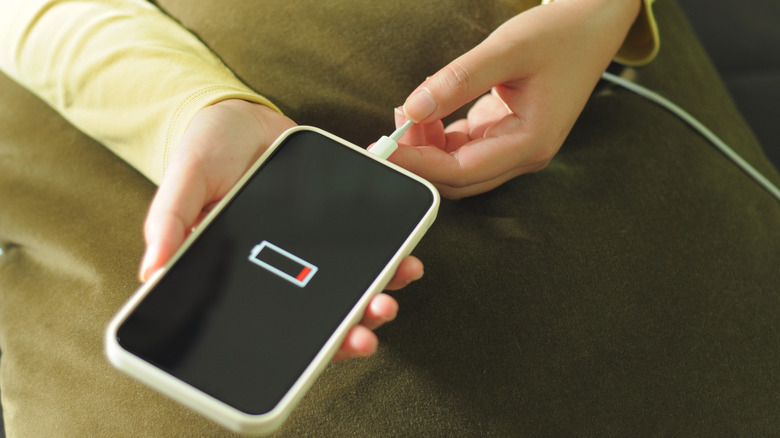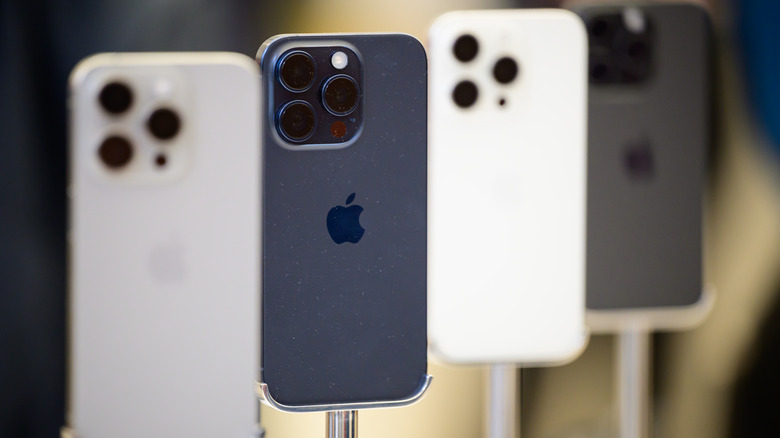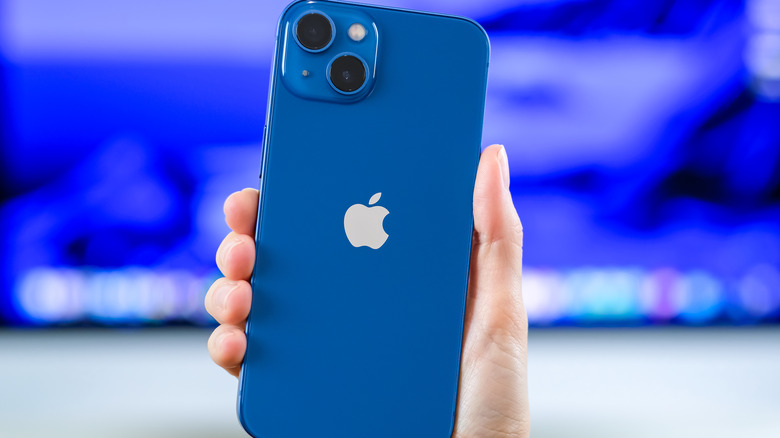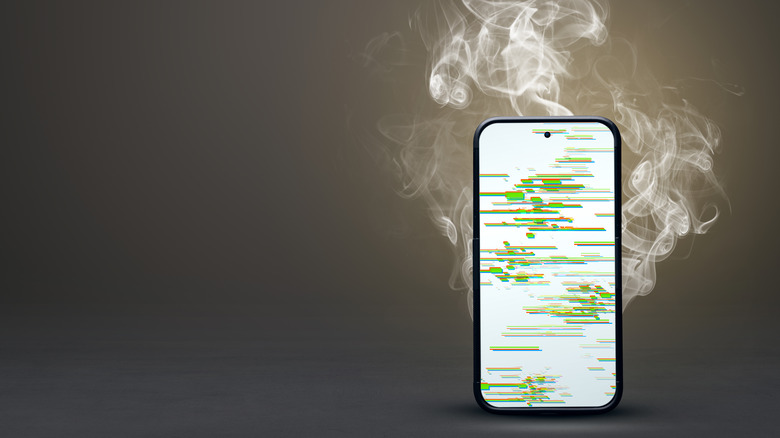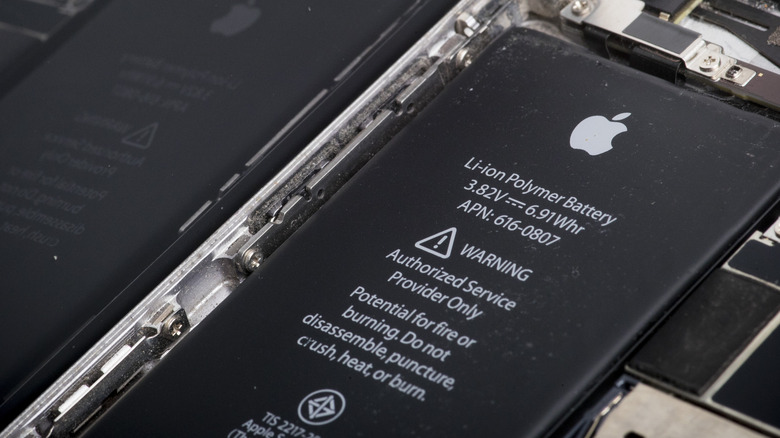5 Signs You May Need To Replace Your iPhone Battery
Anyone who's ever had a failing iPhone battery knows that it can be a real struggle. There's nothing worse than being an hour away from home without a charger, and then suddenly, your phone is telling you that it's dying, or it quickly becomes so hot to the touch that it turns off. That's why it's important to know the signs of a bad battery, and when to begin looking into replacements. When it comes to iPhones, there are a few common "tells" that will show you that the battery is not having a great time.
Apart from diagnosing and troubleshooting, Apple makes knowing this fairly easy, as the phone itself comes with features that will help you keep track of the battery before it starts to fall apart. A bad iPhone battery also doesn't mean you have to fork over the cash for a new phone. Batteries are replaceable at any phone repair place for a fee, or even by yourself, at home. If it happens too soon Apple even has options that may allow you to get it replaced for free, which you'll learn more about later in the article. Fortunately, some of the issues with iPhone batteries can also be fixed yourself, and we don't mean having to get a whole new battery.
Your iPhone battery runs out too quickly
One of the danger signs you'll most likely spot first is fairly simple: Your battery drains faster than it should. iPhones use lithium-ion batteries, which are made to last a certain number of cycles. A cycle is not counted by every time the phone charges, but by every time the battery is drained to 100% of its capacity. As an example, a cycle can be using 75% of the phone's battery and then charging it, but it doesn't end there. If you use 25% the next day, that still represents a complete cycle even with the interruption to charge.
As the battery ages chemically, you may notice that you're going through charge cycles more quickly. This impacts the life expectancy of the phone itself. As the battery degrades and you go through charge cycles more quickly, meaning the phone itself needs to be charged more frequently. A phone battery that depletes faster than you know it could be an indication that it's on its way out.
A good way to prevent this problem is to take care of battery health before issues ever crop up. Avoid charging your phone over 80%, do not leave it to charge overnight, and plug it in before it hits 20%. That's the basic TLC for a lithium-ion battery, and it could prolong your battery life. However, eventually, if you use your iPhone long enough, the battery will start to fail — that's just how it is.
Your iPhone is suddenly slow and glitchy
A faulty battery isn't the only reason your iPhone may suddenly start to slow down and get glitchy. The phone may start to struggle with actions that previously didn't take very long, like opening apps, changing settings, or streaming media.
If you have an iPhone running on any operating system newer than iOS 11.3, a slower-running phone may also be a sign that you're being throttled. Throttling is when Apple purposely slows down phones that have older batteries or batteries that are starting to degrade. The goal is to prolong your phone's life, even if at the cost of performance.
To check throttling, go to your Settings and then choose the Battery option to check the Battery Health. If your phone is being throttled, you'll see a message about Peak Performance Capacity, telling you that the battery is "unable to deliver the necessary peak power." While you can disable this to speed your phone back up, it may not be the best option. This is because, if your battery health is low, then you should consider getting your battery replaced for overall phone health. If you just leave it be, it might become the least of your problems.
Your iPhone is shutting down
Your iPhone may shut down prematurely due to a quickly draining battery, but battery issues can also cause abrupt shutdowns that seemingly come out of nowhere. Sometimes this happens because your battery is too hot or too cold due to environmental factors or overcharging. Other times it's because the chip inside your iPhone is overcompensating to adjust for a failing battery.
One way to help prevent this from happening is to allow Apple to throttle your phone. If your iPhone has not automatically done that, you can revisit the steps in the previous section to turn the feature on. In addition, if you suspect the temperature may play a part, avoid using your iPhone out in the sun; this especially applies to resource-heavy apps, such as Snapchat or YouTube.
If you want to preserve performance then you should minimize the amount of apps and other phone features that require a lot of processing power. This should only be done until you can get your battery replaced. Continuing to use a phone when the battery is on its last legs will just risk damage to its internal components.
Your iPhone gets too hot
The battery's deterioration means that energy can't transfer as efficiently as it can with a fully functional battery. That same deterioration can also cause the voltage to fluctuate. Any situation in which certain parts of the phone have to work harder than they're supposed to, or take on more of the brunt of keeping the phone power, can cause issues.
When an iPhone's processor is stressed beyond its limits, it causes the phone itself to physically heat up. This heat can make the battery swell. A swollen battery can bulge and put pressure on other parts of the phone, as well. At that point, you know it's time to act. While the battery itself is an easy thing to replace with the help of any knowledgeable phone repair service, the rest of your iPhone is usually not. When the damage begins to extend to internal components, such as the motherboard, the internal storage, or the power circuits, it may progress to a point at which you need a completely new phone.
This is why it's important to act quickly if you've noticed that your iPhone tends to overheat. Moreover, for overall battery health, avoid using the phone when you're charging it. It's okay to send a quick text, but watching YouTube while plugged in only adds extra heat to an already warm device.
Your iPhone tells you that your battery health is degrading
iPhones come with a feature that will tell you the percent of your battery health. A normal, functional iPhone battery should be at or above 80% of the original capacity. The original capacity is considered to be around 1000 charge cycles. This means that discharging the battery down to zero and recharging it roughly once a day will ideally mean your phone lasts just over three years, but of course, your mileage may vary. The way you use your iPhone plays a part in this; if you mostly make calls or send texts, your battery takes less of a hit if you're on Instagram for a couple hours a day.
Sometimes batteries don't last that long, though. If your iPhone's battery is below 80% and you've had the phone for under a year, you're kind of in luck. Degrading under 80% within one year indicates some kind of defect in the battery, and that's often covered by warranty. Your best bet is to reach out to Apple and try to get it replaced for free.
If your phone is not under warranty, but the battery health is under 80%, it'll continue working for a while. However, the issues we outlined in this article will become more and more common until you either get a new battery or a whole new iPhone, so it's usually better to address the problems sooner rather than later.
